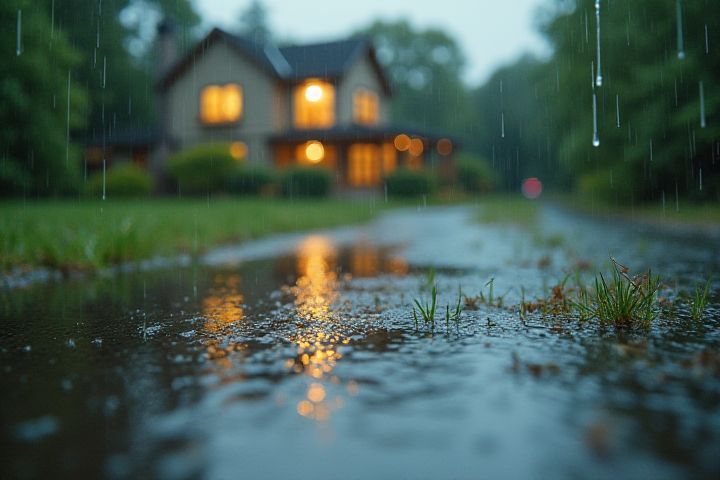
A house may develop a distinct smell after rain due to the moisture interacting with various materials inside and outside your home. This phenomenon often results from increased humidity, which can activate mold and mildew spores, creating musty odors. Additionally, rain can stir up earthy compounds known as petrichor, which can infiltrate your indoor air if windows are open or through porous walls. Other contributing factors include damp basements and wet carpets, which naturally produce odors when saturated. Keeping your home well-ventilated and dry can help mitigate these smells and reduce the likelihood of mold growth.
Why House Smell After Rain
Geosmin release
After rain, the distinct earthy smell often associated with your surroundings is largely due to the release of a compound called geosmin. This organic compound, produced by soil-dwelling bacteria like Actinobacteria, is released when raindrops disturb the soil. Studies indicate that even minuscule amounts of geosmin, around 10 parts per trillion, can significantly affect your olfactory senses, triggering a strong earthy scent. This phenomenon not only enhances your sensory experience but also signifies a healthy ecosystem where microbial activity thrives.
Petrichor phenomenon
The distinct smell that occurs after rain, known as petrichor, is caused by the release of compounds from soil and plant oils. When raindrops hit the ground, they displace tiny air bubbles that carry these aromatic substances, primarily geosmin and plant oils, into the atmosphere. Research indicates that geosmin's concentration can reach approximately 0.5 parts per billion, yet it's potent enough to be detected by humans at incredibly low thresholds. As a result, the refreshing scent you associate with rain evokes feelings of nostalgia and relaxation, enhancing your environment's overall sensory experience.
Soil bacteria activity
After rain, the distinct earthy smell, often described as "petrichor," can be attributed to soil bacteria activity. These microorganisms, particularly actinomycetes, release volatile compounds into the air, enhancing the olfactory experience of fresh rain. As water saturates the soil, it triggers the release of organic materials, which bacteria decompose, further intensifying the aroma. Your perception of this smell connects to a blend of chemical reactions and biological processes that signal a flourishing ecosystem beneath your feet.
Plant oil release
After rain, the earthy scent known as "petrichor" is largely attributed to plant oils released from vegetation. These oils accumulate on soil and plant surfaces, and when rain falls, they are released into the air, creating a distinctive aroma. The moisture enhances these volatile compounds, intensifying their fragrance as they vaporize. You may notice this comforting smell in your home as it seeps in through open windows or fresh air vents, reminding you of the natural world outside.
Mold and mildew presence
After rainfall, your house may develop a musty smell due to the increased humidity levels that promote mold and mildew growth. Indoor humidity can rise above 60%, creating a perfect environment for these fungi to thrive, especially in damp corners and hidden spaces. Mold spores can grow on various surfaces, including walls, ceilings, and furniture when moisture levels are high, leading to unpleasant odors. It's crucial to regularly monitor moisture levels and ensure proper ventilation to mitigate these issues and maintain a healthy living environment.
Increased humidity
After rain, increased humidity levels can lead to a distinctive musty smell in your house. This phenomenon occurs because high moisture content promotes the growth of mold and mildew, which thrive in damp environments. As the humidity seeps into your home, it can cause porous materials like wood, carpets, and upholstery to retain moisture, further exacerbating the odor. To combat this, consider using a dehumidifier to maintain indoor humidity levels between 30% and 50%, ensuring a fresher and dryer living space.
Damp organic materials
After rain, a house may develop an earthy odor primarily due to damp organic materials. When moisture penetrates building materials like wood, drywall, or insulation, it creates a favorable environment for mold and mildew growth. These fungi thrive on organic matter, releasing volatile organic compounds (VOCs) that contribute to the distinct musty smell. To mitigate this issue, ensure proper ventilation and control humidity levels below 60% to prevent the accumulation of moisture and maintain a fresher indoor atmosphere.
Air pressure changes
After rainfall, the decrease in atmospheric pressure can lead to the release of earthy compounds from the soil, known as petrichor. This phenomenon occurs when raindrops disturb the ground, releasing oils and spores that often contribute to the unique scent associated with fresh rain. Furthermore, the dampness can cause mold and mildew to grow indoors if ventilation is poor, resulting in musty odors. Maintaining proper air circulation and humidity levels in your home can help mitigate these post-rain smells, enhancing your living environment.
Ozone production
After rain, many people notice a distinct smell in the air, often attributed to the production of ozone. Ozone (O3) is created when lightning interacts with oxygen molecules, resulting in a fresh and invigorating scent. This phenomenon, known as the "petrichor," occurs as ozone travels down from the atmosphere and mixes with other compounds released from soil and vegetation. The unique aroma not only signals the end of dry weather but also enhances the sensory experience of a refreshed environment, making your surroundings feel cleaner and rejuvenated.
Environmental debris
After rain, houses often emit a distinct earthy aroma primarily due to the interaction of water with environmental debris. The moisture activates naturally occurring compounds such as geosmin and microbial byproducts, which are prevalent in soil and decaying organic matter. This phenomenon can be particularly noticeable in areas with rich vegetation or old wood, where mold spores and plant material contribute to the scent. Ensuring proper ventilation and regular cleaning can help reduce the intensity of these odors in your home.
